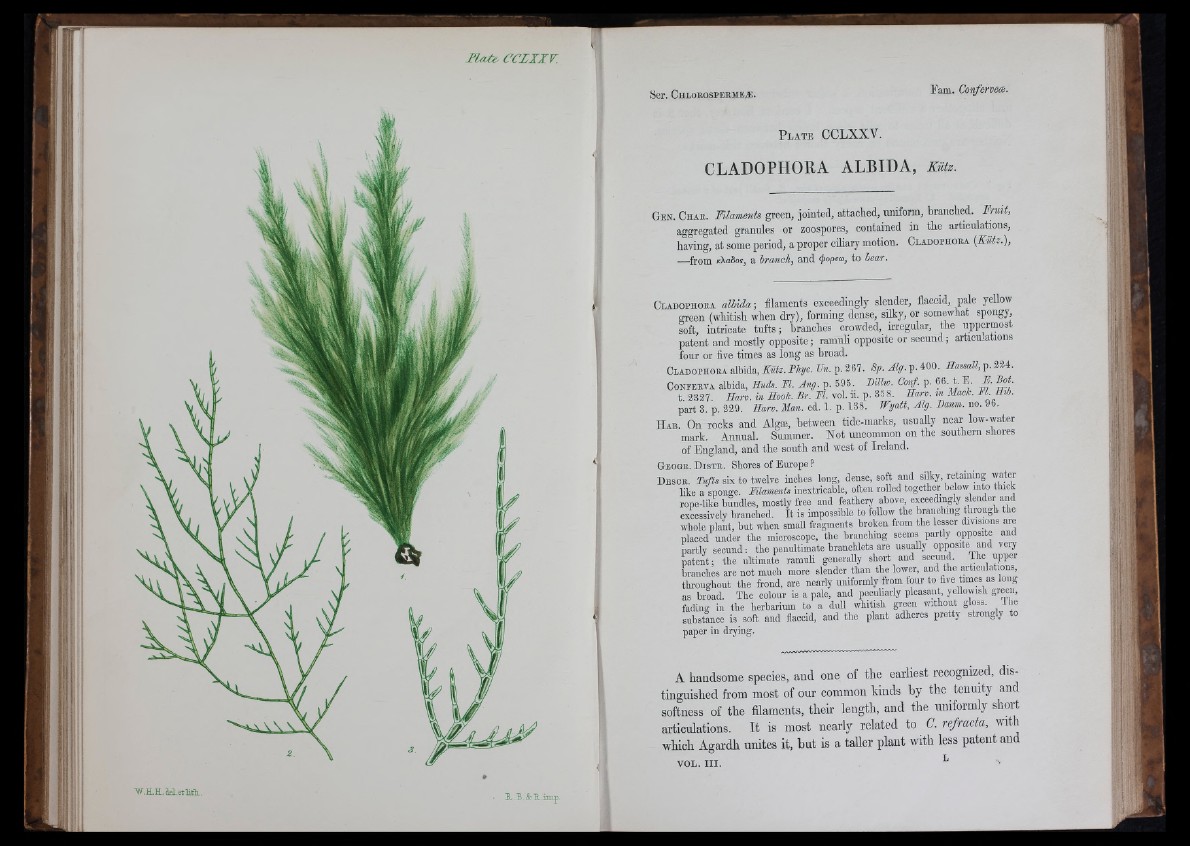
p i ^ c c iix r .
! !
P l a t e CCLXXV.
CLADOPHORA ALBIDA, Kütz.
G e n . C hak. FUameuU gre en, jo in te d , a tta ch ed , uniform, b ran ch ed . Fruit,
ag g reg ated g ran u le s o r zoospores, co n ta in ed in th e a rtic u la tw n s,
h aving, a t some p eriod, a p ro p e r ciliary m o tio n . Cladophoea (K a tz ) ,
— from /iXaôos, a branch, an d i>opeo>, to bear.
Cladophoea albida; filaments exceedingly slender, flaccid, pale yellow
green (wlritish when dry), forming dense, süky, or somewhat spongy,
soft, intricate tu f ts ; branches crowded, üregular, the uppermost
patent and mostly opposite; ramuli opposite or secund; articu.ations
four or five times as long as broad.
C l a d o p h o e a albida, Kütz. Phyc. Un. p. 267. Sp. Alg. p. 400. Eassall, p. 224.
CONPERTA albida, Huds. M. Ang. p. 595. Billw. Co,f. p. 66. t. E. K. Bot
t. 2327. Harv. in Hook. Br. M. vol. ii. p. 35 8. Harv. in Mack. F l Hzb.
p a rt 3. p. 229. Harv. Man. ed. 1, p. 138. Wyatt, Alg. Banm. no. 96.
H ab. On rocks and Alg®, between tide-marks, usually near low-water
mark. Annual. Summer. Not uncommon on the southern shores
of England, and the south and west of Ireland.
Geoge. Dis t e . Shores of Europe ?
D e sc e . Tufts six to twelve iuches long, dense, soft and silky, retaiiung water
hke a sponge. Filaments inextricable, often rolled together below into thick
rope-like bundles, mostly free and feathery above, exceedingly slender and
excessively branched. I t is impossible to follow the branching through the
whole plant, hut when small fragments broken from the lesser divisions are
placed under the microscope, the branching seems partly opposite and
partly secund •, the penultimate brauchlets are usually opposite and very
patent; the ultimate ramuli generaUy short and secund. The uppei
branches are not much more slender than the lower, and the articulations,
throughout the frond, are nearly uniformly from tour to five times as long
as broad. The colour is a pale, and peculiarly pleasant, yellowish gieeii,
fading in the herbarium to a dull whitish green without gloss. Ih e
substance is soft and flaccid, and the plant adheres pretty strongly to
paper in drying.
A handsome species, and one of the earliest recognized, distinguished
from most of our common kinds hy the tenuity and
softness of the filaments, their length, and the uniformly short
articulations. It is most nearly related to C. refracta, with
which Agardh unites it, hut is a taller plant with less patent and
VOL. I I I . ^
. E-B.fcE.i